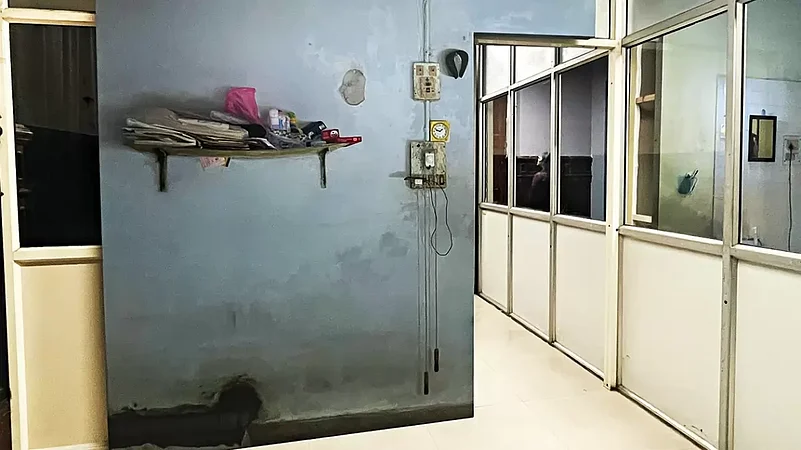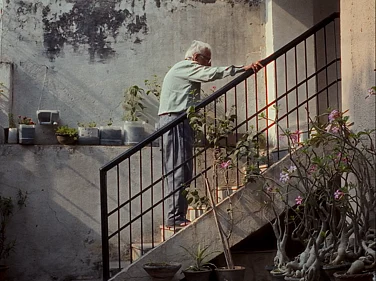Fiction is the lie through which we tell the truth
—Albert Camus
A neatly stacked and arranged cupboard full of utensils, middle-class ordering of things, the plastic dabbas (containers) used for hoarding purposes, sets of glass bowls and cups that are used only when guests visit—this isn’t a real kitchen, it is its shadow. A middle-class setup is home to a multitude of stories—stories of space crunch, aspirations, limited income, affordability and the desire to decorate the space by buying inexpensive items.
Abir Karmakar’s paintings look for meaning in everyday life. Through the minute details of objects like cupboards, television or kitchen utensils painted on canvas in oil, the artist takes us to the private interior of strangers. He takes us to the post-truth world where the real and fiction merge.
“Middle-class families are hoarders. We hardly discard anything. Objects like grandfather’s suitcase and the old television try to fit in along with the modern furniture that we keep buying,” says Karmakar. The juxtaposition of an old Godrej almirah with a new-age dressing table covered by Sunmica sheets pushes the audience to explore the interaction between traditional and modern.
For his ‘Home’ series, which was displayed at the Kochi-Muziris Biennale 2016, he visited a family in Bhuj, Gujarat. He took out components from their rooms and recreated their interiors in a Portuguese bungalow-turned-gallery. “The family I visited had been staying there for generations. When their domestic attributes were reproduced in a Portuguese bungalow in Kochi, far away from Bhuj, there was overlapping and amalgamation of different cultural aspects,” says Karmakar.
In the series, he placed outdated and modern components together in a room. Among the meticulously painted and neatly arranged objects in the cupboard, one could find an old box television that he stretched in width giving the impression that it was trying to take the shape of a new-age flat television to fit into the modern attributes of life.
Karmakar’s excellence lies in a space where norms of binary give way to transcendence. His art is all about blurring the binaries. It is deconstructive in its own essence.
The ‘Home’ series was later renamed ‘Displacement’ and the Kutch home was recreated in a Mumbai gallery from November 2017-February 2018. Birgid Uccia, the curator of his series ‘Displacement’, writes: “Abir Karmakar’s quest of ‘What is home?’ deconstructs the topos of ‘home’.” Through the large-size paintings, he looks beyond the immediate—perhaps in search of the meaning that transcends real/fiction binary.” The ‘Home’ series invited the audience to explore the overlapping of public and private space.
The Blur Line
“My work blurs the line between private and public. It is beyond the binary of ethical/unethical, moral/immoral, private/public,” says the artist. His 2011 series ‘Scent’ shows a hotel bed that becomes a space of private-public interaction. “We go to a public place and check in to hotels where we use beds that might have been used by others just before us. So, it represents the interface between public and private,” says Karmakar.
He also made a video for this series. He called three of his male friends and asked them to sleep naked on his bed. They were captured through a surveillance camera. “In a middle-class family, you hardly have any private space. For them, it was a new experience to sleep naked on a bed,” he says. Throughout those 7-8 hours, they touched themselves intimately. Karmakar took all those shots and made an overlap. “It certainly feels as if they are touching each other. As touching is one of the major components of intimacy, it blurred all the boundaries,” he says.
In his early twenties, when he started his career as a professional artist, he made several self-portraits in the intimate spaces of his house. When his connection with the washroom and other very private spaces came to the fore, some people termed his work as ‘vulgar’. “There was no vulgarity. I only tried to explore different shades of masculinities in the new millennium,” says Karmakar, who did his Masters in Fine Arts (MFA) from Maharaja Sayajirao University of Baroda in Gujarat.
Life Experiences Inspire Art
This idea of observing micro-level objects and their significance comes from his personal experience of migration. His grandfather came from Chittagong, Bangladesh during partition. His father spent most of his life in Uttar Pradesh and eventually settled in Siliguri. “I am settled in Baroda. Over the years, I have experienced how the first-generation migrants in a region hold on to their things. This inevitable desire to hold on to the past in a culturally different zone is perhaps what makes us ‘hoarders’,” Karmakar notes.
He chooses houses that don’t have ‘homogenous aesthetics like the modern apartments.’ “It is in the homes of strangers that you can see things from a clinical distance. In our own homes, we can’t observe the micro-level things that actually bear our memories and cultural essence,” he says. While his early body of work features human figures and their interaction in intimate spaces, in the past decade, he has mostly focused on what he calls, “invisible bodies”—the domestic interiors, memories and the objects.
Installation is Key
“One shouldn’t undermine the process of making a large-scale oil painting on canvas. Nowadays, everything is rushed and we don’t have time. In this backdrop, I want to give time to the work and observation. Sometimes, it takes a year to complete a painting,” Karmakar says. The process of installation and how his work is placed at galleries is also of great significance for the artist. “For my ‘Home’ series, the lighting of the room was such that people were able to get real-time experience. The light kept changing throughout the day and it gave people an impression that they were visiting someone’s place,” he says.
He uses the studio photography technique for these large-size paintings. “Earlier, people used to go to studios to click photographs with different backgrounds. I use the same technique to recreate rooms of strangers where I invite people to private domestic interiors. This is not the real space, it is the illusion of it,” Karmakar says and adds in such a set up, real and fiction merge to create a new meaning.
A major aspect that drives his artwork is ‘experience’. “In my works you experience a different world—a transition, an impermanence. You try to hold something, but can’t; you try to touch something, but you can’t. This illusion of real and fiction reflects on my politics of art,” says Karmakar.
One can find a reflection of Dutch genre painting in his works where the everyday elements are portrayed meticulously. “In my childhood, I used to see amazingly illustrated Russian literature that had a huge impact on me. So, I do have a European influence in my works,” says Karmakar.



























